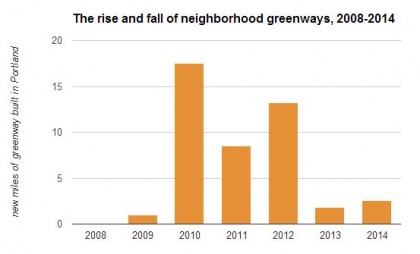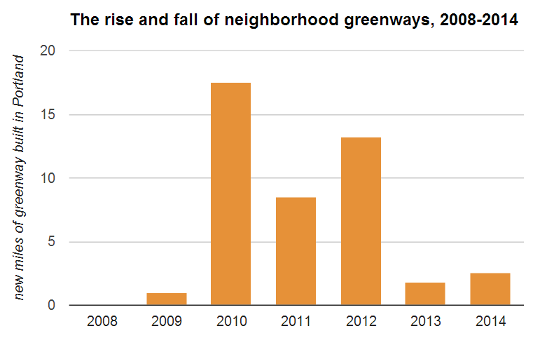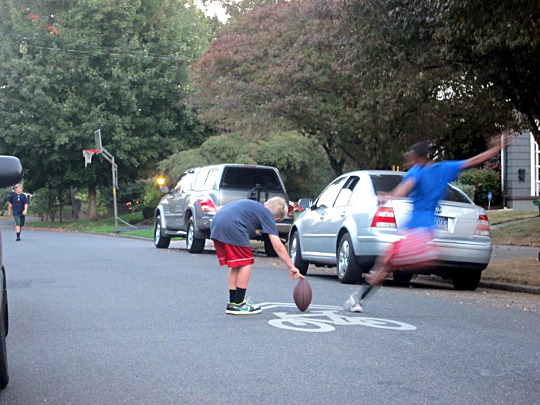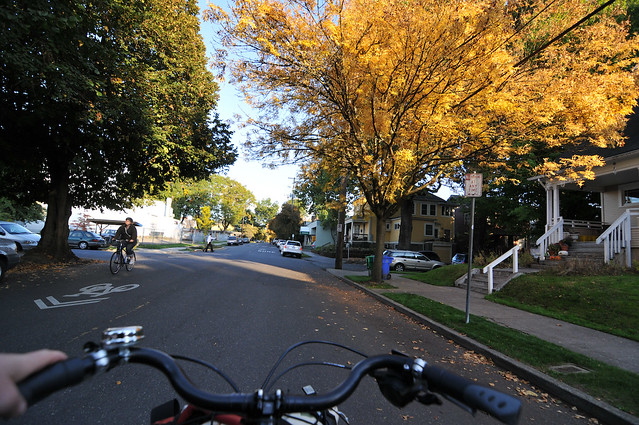
(Photos by J.Maus and M.Andersen/BikePortland)
If Portland has contributed any innovations of its own to the craft of designing great streets, it’s this two-word idea: neighborhood greenways.
A remix of ideas from Utrecht and Vancouver BC, these low-cost retrofits of low-traffic side streets — adding speed humps, sharrow markings, traffic diverters and signalized crossings of big arterials — have taken the national bike world by storm since Portland’s Greg Raisman and Mark Lear developed the concept in 2008 or so. In 2010, a citywide network of greenways became the first priority to emerge from Portland’s landmark 25-year bike plan.
The concept went viral.
Within a few years, Transport for London had flown a planner to camp out at Raisman’s house and learn about the system. Chicago is now planning to build a 40-mile greenway network by 2020. Los Angeles, Ithaca, Santa Monica and St. Louis are all planning their own greenways. Seattle may be the biggest fan of all: it has its own advocacy organization devoted entirely to the concept, with paid staff and 3,000 people on its mailing list.
Portland, meanwhile, has eliminated its dedicated funding for neighborhood greenways.
Planned greenways on SE 19th Avenue near Sellwood; NE 77th and Sacramento; and SE Mill, Market and Main between I-205 and 130th Avenue have all been put on ice. Improvements to older greenways like NE Tillamook, SE Salmon, SE Ankeny or SE Clinton are indefinitely postponed, too. This year, only a few miles of the grant-funded 50s Bikeway will add to the network.
Why? And what’s likely to happen next?
Advertisement
The city’s decision to nearly eliminate local funding for neighborhood greenway construction isn’t due to any conscious opposition in the Portland Bureau of Transportation. At every level, PBOT officials are proud of the program and eager for it to resume.
Instead, it’s a sign of just how severe PBOT’s revenue crunch is — and of the sacrifices the city has made in order to fulfil the $100 million commitments of former Mayor Sam Adams to the new Sellwood Bridge and Orange Line MAX, and also Mayor Charlie Hales’ $11.3-million promise to change PBOT’s image by paving — or in many cases, as it turned out, fog-sealing — 100 miles of city streets.
“The neighborhood greenways become the bus system for biking and walking. Our big commercial street projects are more akin to the light rail and streetcar projects.”
— Greg Raisman, PBOT traffic safety specialist
“With the launch of the bike plan, we had about about $1.3 million for bike stuff” each year, PBOT Active Transportation Manager Dan Bower said in an interview. “It wasn’t really a line item for neighborhood greenways, per se, but … because the implementation strategy was for greenways, it went to greenways.”
The strategy looked like this: low-cost neighborhood greenways would make biking more popular, and that popularity would then drive political support for a far more expensive protected bike lane network that would make biking the fastest and most comfortable way for Portlanders to make trips of 3 miles or less.
At $250,000 per mile — most of it going to new traffic signals that cross big streets — greenways are “a way to put a bunch of miles on the ground really quick and serve a lot of people,” Bower said. “It’s a great way to get more and more people out riding. it’s a base network.”
“In an American context, neighborhood greenways really make a lot of sense, because 70 percent of roads in America are residential,” Raisman said. “It’s like using the transit model for active transportation. The neighborhood greenways become the bus system for biking and walking. … Our big commercial street projects are more akin to the light rail and streetcar projects.”
The strategy seemed plausible. But it didn’t survive the city’s 2013 budget.
As the city refocused PBOT’s priorities on shoring up a street maintenance backlog that the city’s auditor had warned was dangerously underfunded, its standing budget for biking and walking projects was halved, from about $2 million to about $1 million. Due to the size of that cut, Bower decided he had no choice but to eliminate all the “buckets” for new projects, including the biggest one: new greenways.
Bower said his department is trying to make the remaining million go as far as it can, including continued sidewalk work, new rapid-flash crossing beacons and local matches for federal grants, which are now the main funding source for new greenways.
Advertisement
“We’re using that million bucks to match the 20s Bikeway, the 50s Bikeway, the 100s, the 130s and the 150s — those are all funded in grants,” Bower said.
But Raisman and Bower said the city hasn’t steered every grant application toward greenways because, essentially, they’re hard to sell to grantors like Metro — not flashy and not perceived as transformative in the way a big project might be.
So what’s next for neighborhood greenways, and for the fate of the 2010 bike plan in general? Though the federally funded 20s, 50s, 100s, 130s and 150s greenways will keep rolling out until 2017, it’s not clear if or how PBOT will find the money to once again make greenways the focus of their effort to improve local biking.
The number of Portlanders using bikes for their commutes, seen as a useful indicator of bike transportation in general, leveled off in 2008 and hasn’t increased since. It’s not clear if or how that’s related to the city’s shift to prioritizing greenways, which are safer, more comfortable and more expensive than door-zone bike lanes but also tend to be less direct and may be less intuitive to new bikers.
Thursday was the third of three “town halls” at which Mayor Hales, Transportation Commissioner Steve Novick and PBOT Director Leah Treat heard from citizens about which projects should be included in the city’s new transportation spending package — a measure into which PBOT is piling more or less all of its hopes.
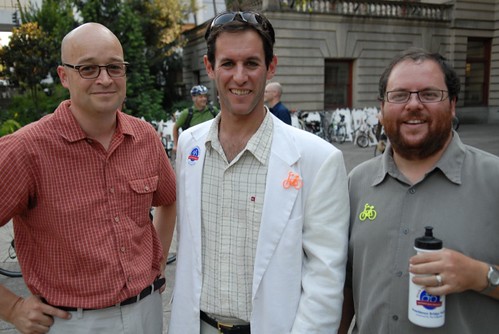
left, and Greg Raisman, right, with former Bicycle
Transportation Alliance Director Scott Bricker in 2008.
You can register your own opinion about the city’s priorities by emailing the man running that campaign: Mark Lear, the co-creator of the neighborhood greenways concept, now reassigned to manage the revenue effort. He’s at mark.lear@portlandoregon.gov. The city also has an online survey that takes 10 minutes or so to complete.
Cathy Tuttle, executive director of Seattle Greenways, said in an interview Wednesday that Portland should be proud of its role in popularizing greenways, which she said aren’t so much a cheap way to build bikeways but a new way of thinking about what a city street can be.
“People love their parks, and we’re trying to get people to love their streets the same way,” Tuttle said. “Because they are just another big piece of canvas as far as I’m concerned.”
The real “missing piece” in Portland’s neighborhood greenway network, Tuttle said, is that its biggest advocates have come mostly from the city government, not from private citizens.
“It really does have to come from the community,” Tuttle said. “It can’t be something that comes from the government. Because once it does come from the government, people lose that sense of ownership. … To actually get that funding, we need to own them in that way.”
